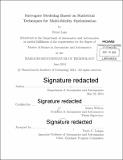Surrogate modeling based on statistical techniques for multi-fidelity optimization
Author(s)
Lam, Remi Roger Alain Paul
DownloadFull printable version (8.241Mb)
Other Contributors
Massachusetts Institute of Technology. Department of Aeronautics and Astronautics.
Advisor
Karen Willcox.
Terms of use
Metadata
Show full item recordAbstract
Designing and optimizing complex systems generally requires the use of numerical models. However, it is often too expensive to evaluate these models at each step of an optimization problem. Instead surrogate models can be used to explore the design space, as they are much cheaper to evaluate. Constructing a surrogate becomes challenging when different numerical models are used to compute the same quantity, but with different levels of fidelity (i.e., different levels of uncertainty in the models). In this work, we propose a method based on statistical techniques to build such a multi-fidelity surrogate. We introduce a new definition of fidelity in the form of a variance metric. This variance is characterized by expert opinion and can vary across the design space. Gaussian processes are used to create an intermediate surrogate for each model. The uncertainty of each intermediate surrogate is then characterized by a total variance, combining the posterior variance of the Gaussian process and the fidelity variance. Finally, a single multi-fidelity surrogate is constructed by fusing all the intermediate surrogates. One of the advantages of the approach is the multi-fidelity surrogate capability of integrating models whose fidelity changes over the design space, thus relaxing the common assumption of hierarchical relationships among models. The proposed approach is applied to two aerodynamic examples: the computation of the lift coefficient of a NACA 0012 airfoil in the subsonic regime and of a biconvex airfoil in both the subsonic and the supersonic regimes. In these examples, the multi-fidelity surrogate mimics the behavior of the higher fidelity samples where available, and uses the lower fidelity points elsewhere. The proposed method is also able to quantify the uncertainty of the multi-fidelity surrogate and identify whether the fidelity or the sampling is the principal source of this uncertainty.
Description
Thesis: S.M., Massachusetts Institute of Technology, Department of Aeronautics and Astronautics, 2014. Cataloged from PDF version of thesis. Includes bibliographical references (pages 71-74).
Date issued
2014Department
Massachusetts Institute of Technology. Department of Aeronautics and AstronauticsPublisher
Massachusetts Institute of Technology
Keywords
Aeronautics and Astronautics.